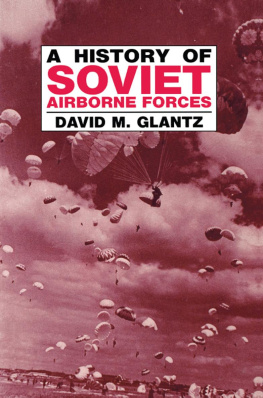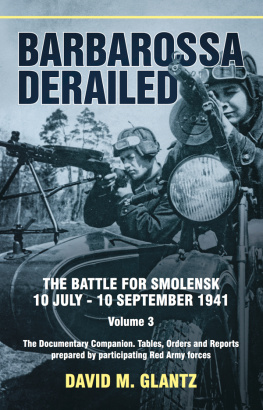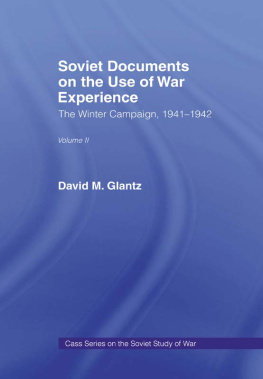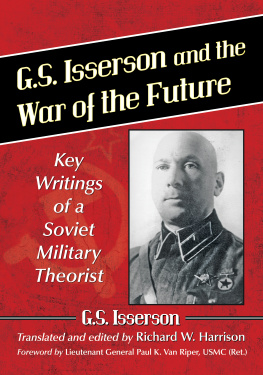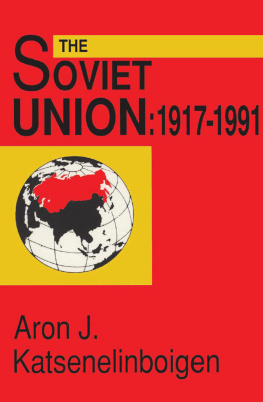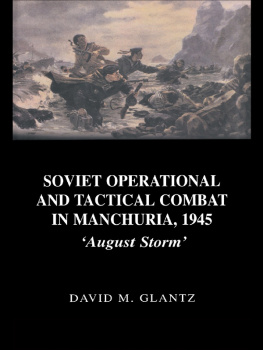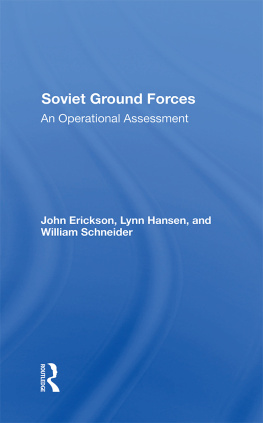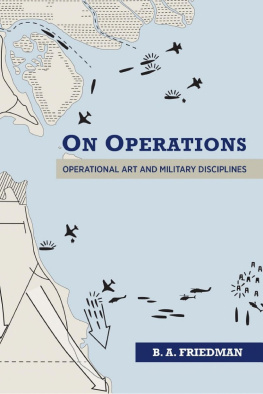THE EVOLUTION OF
SOVIET OPERATIONAL ART
1927-1991
VOLUME II
ROUTLEDGE SERIES ON THE SOVIET STUDY OF WAR
(Selected Translations)
Series Editor: David M. Glantz
This series examines what Soviet military theorists and commanders have learned from the study of their own military operations. Separate volumes contain annotated translations of Soviet works analysing their own experiences, as well as the works of important Soviet military theorists and collections of Soviet articles concerning specific campaigns, operations or military techniques.
1.Harold S. Orenstein, translator and editor, Soviet Documents on theUse of War Experience, Volume I, The Initial Period of War 1941, with an Introduction by David M. Glantz.
2.Harold S. Orenstein, translator and editor, Soviet Documents on theUse of War Experience, Volume II, The Winter Campaign1941-1942, with an Introduction by David M. Glantz.
3.Joseph G. Welsh, translator, Red Armor Combat Orders: CombatRegulations for Tank and Mechanized Forces 1944, edited and with an Introduction by Richard N. Armstrong.
4.Harold S. Orenstein, translator and editor, Soviet Documents on theUse of War Experience, Volume III, Military Operations 1941 and1942, with an Introduction by David M. Glantz.
5.William A. Burhans, translator, The Nature of the Operations of Modern Armies by V. K. Triandafillov, edited by Jacob W. Kipp, with an Introduction by James J. Schneider.
6.Harold S. Orenstein, translator, The Evolution of Soviet OperationalArt, 1927-1991: The Documentary Basis, Volume I, OperationalArt, 1927-1964, with an Introduction by David M. Glantz.
7.Harold S. Orenstein, translator, The Evolution of Soviet OperationalArt, 1927-1991: The Documentary Basis, Volume II, OperationalArt, 1965-1991, with an Introduction by David M. Glantz.
First published in 1995 in Great Britain by
Routledge
2 Park Square, Milton Park, Abingdon, Oxon, OX14 4RN
270 Madison Ave, New York NY 10016
Transferred to Digital Printing 2009
Copyright 1995 Routledge & Co.
British Library Cataloguing in Publication Data
Evolution of Soviet Operational Art,
192791: Documentary Basis. Vol.2:
Operational Art, 196591. (Routledge Series
on the Soviet Study of War; No.7)
I. Orenstein, Harold S. I. Series
355.00947
ISBN 0-7146-4548-6 (cloth)
ISBN 0-7146-4229-0 (paper)
Library of Congress Cataloging in Publication Data
The evolution of Soviet operational art, 1927-1991.
p. cm. (Routledge series on the Soviet study of war; 6-7) Includes index.
Contents: v. 1. Operational Art, 1927-1964 v. 2. Operational art, 1965-1991.
ISBN 0-7146-4547-8 (v. 1) ISBN 0-7146-4548-6 (v. 2) (cloth)
ISBN 0-7146-4228-2 (v. 1) ISBN 0-7146-4229-0 (v.2) (paper)
1. Operational art (Military science)History20th century.
2. Soviet UnionHistory, Military. I. Series
U162.E96 1995
355.02dc20
94-39330
CIP
All rights reserved. No part of this publication may be reproduced in anyform or by any means, electronic, mechanical, photocopying, recordingor otherwise, without the prior permission of Routledge
Typeset by Regent Typesetting, London
Publisher's Note
The publisher has gone to great lengths to ensure the quality of this reprint but points out that some imperfections in the original may be apparent.
Contents
CHAPTER SIX
Articles and studies published during the period after 1964 evidence movement away from preoccupation with nuclear questions, first through an examination of the historical roots of operational art, and finally, by 1968, by demonstrating acute awareness that traditional operational techniques applied within a modern context. These articles were, in fact, precursors to the period of the 1970s, when operational art and conventional operations in a nuclear scared context again became preeminent Soviet military concerns.
A capstone Soviet work on the development of operational art appeared in 1965. Entitled Problemy strategii i voyennogo iskusstva sovetskikh voyennykh trudakh (1917-1940) [Problems of strategy and operational art in Soviet military works (1917-1940)], the two-volume work contained selections from the writings of a host of interwar theorists, many of which had not been available to readers since the 1930s. The introduction to the book by the then Chief of the Soviet Army General Staff, Marshal of the Soviet Union M. V. Zakharov, emphasized the importance of the writings and officially sanctioned the rehabilitation process of such writers as Svechin, Tukhachevsky, and a host of forgotten or scarcely remembered theorists on operational art.
Also during 1965, VIZh published a lengthy retrospective account of the development of operational art in the 1930s by the surviving theorist of the interwar years, G. Isserson. The article provided fresh details on the process by which operational art was developed, exposed the views and contributions of those who were purged in the late 1930s, and candidly explained for the first time how Stalinism had adversely affected the process.
A subsequent 1965 article by Colonel A. Golubev complimented and critiqued the piece by Isserson and also fully rehabilitated the key strategic and operational theorist, A. Svechin. Golubev resurrrected the great strategic debate of the 1920s regarding the contending strategic schools of attrition and annihiliation, examined the works of Tukhachevsky, Triandafillov and others, and cast new light on the concept of successive operations.
The following year, Major General N. Pavlenko, writing in VIZh, authored a substantial piece addressing the strategic context for the development of operational art in the 1920s, again reviewing in detail the writings and views of purged military theorists, in particular Svechin and Tukhachevsky. Pavlenko's article focused on the evolution of strategic offensive concepts within the parameters of the strategic debate and highlighted the role of successive operations.
The 1968 article by Chief of Soviet Ground Forces and Deputy Minister of Defense Army General I. Pavlovskiy applied the same critical eye to the development of operational art in the Great Patriotic War and reflected a broader new trend as major new books appeared on the subject (for example, Colonel General P. A. Kurochkin's Obshchevoyskovaya armiya nastuplenii [The combined-arms army on the offensive]).
Completing the process of reinvigorating the analytical basis of operational art, in 1970 a key article appeared by Chief of the General Staff, Marshal of the Soviet Union M. V. Zakharov that reviewed in detail the historical development of the concept of the deep operation, the core element of historical operational maneuver. Zakharov underscored the contemporary utility of the deep operation and paved the way for Soviet fixation on operational maneuver, which dominated the next decade and a half. The intellectual ferment is clear in these articles, as is the steady movement away from fixation on nuclear warfare to an increased faith in the utility of conventional operations, a faith which undergirded renewed Soviet interest in operational art.
The collection Voprosy strategii i operativnogo iskusstva


